Fibonacci analysis can improve forex performance for both short and long-term positions, identifying key price levels that show hidden support and resistance. Fibonacci used in conjunction with other forms of technical analysis builds a powerful foundation for strategies that perform well through all types of market conditions and volatility levels.
12th-century monk and mathematician, Leonardo de Pisa discovered a numerical sequence that appears throughout nature and in classic works of art. While his studies were theoretical, these Fibonacci numbers show profitable applications in our modern financial markets, describing relationships between price waves within trends, as well as how far waves will carry before reversing and testing prior levels.
The .386, .50 and .618 retracement levels comprise the primary Fibonacci structure found in charting packages, with .214 and .786 levels adding depth to market analysis. These secondary ratios have taken on greater importance since the 1990s, due to the deconstruction of technical analysis formula by funds looking to trap traders using those criteria. As a result, whipsaws through primary Fibonacci levels have increased, but harmonic structures have remained intact.
For example, it was commonly believed the .618 retracement would contain countertrend swings in a strongly trending market. That level is now routinely violated, with the .786 retracement offering strong support or resistance, depending on the direction of the primary trend. Traders and market timers have adapted to this slow evolution, altering strategies to accommodate a higher frequency of whipsaws and violations.
Historical Analysis
Fibonacci grid applications can be roughly divided into two categories, historical analysis and trade preparation. The first category requires an examination of long-term forex trends, identifying harmonic levels that triggered major trend changes. Active market players will spend more time focused on the second category, in which Fibonacci grids are placed over short term price action to build entry and exit strategies.
There’s great synergy between the two applications because price levels uncovered through long-term historical analysis work well with short-term trade preparation, especially at key inflection points. Since currency pairs oscillate between contained boundaries through nearly all economic conditions, these historical levels can impact short-term pricing for decades.
Given the small number of popular crosses compared to the stocks or bonds, it makes sense to perform a historical analysis on each pair, outlining primary trends and levels that might come into play in coming years. Perform this task by zooming out to weekly or monthly charts, and placing grids across secular bull and bear markets. The analysis only needs to be performed once as long as price action doesn’t exceed the highs or lows of the long term grids.
EURUSD Historical Fibonacci Grid

The EURUSD currency pair came to life in the 1980s near .90000 and traded up to 1.42890 in 1995. It fell to an all-time low at .82300 in 2001 and rocketed to an all-time high at 1.60380 in 2008. A grid placed over the massive uptrend has captured all price action in the last eight years. The initial decline off the rally high ended near the .50 retracement a few months later, with that level providing support during tests in 2010 and 2012. Meanwhile, a 2014 breakdown found new support at the .618 retracement, with the forex pair spending 2015 bouncing along that level.
Trade Preparation
Start your trade preparation analysis by placing a single grid across the largest trend on the daily chart, identifying key turning points. Next, add grids at shorter and shorter time intervals, looking for convergence between key harmonic levels. Similar to trendlines and moving averages, the power of these levels tracks relative time frame, with grids on longer term trends setting up stronger support or resistance than grids on shorter term trends.
Many forex traders focus on day trading, and Fibonacci levels work in this venue because daily, and weekly trends tend to subdivide naturally into smaller and smaller proportional waves. Access these hidden numbers by stretching grids across trends on 15-minute and 60-minute charts but add daily levels first because they’ll dictate major turning points during forex’s 24-hour trading day.
Having a hard time figuring out where to place starting and ending points for Fibonacci grids? Stretching the grid across a major high and low works well in most cases but many traders take a different approach, using the first lower high after a major high or first higher low after a major low. This approach tracks the Elliott Wave Theory, focusing attention on the second primary wave of a trend, which is often the longest and most dynamic.
Interaction with Other Indicators
The reliability of retracement levels to stop price swings and start profitable counter swings directly correlates with the number of technical elements converging at or near that level. These elements can include Fibonacci retracements in other time periods, moving averages, trendlines, gaps, prior highs/lows, and relative strength indicators hitting overbought or oversold extremes.
For example, multiple grids on a daily chart that align the.618 retracement of one trend with the .386 retracement of another trend raise odds that forex pair will reverse at or near that level. Add a 50- or 200-bar moving average and odds increase further, encouraging bigger positions and a more aggressive trading strategy. This methodology applies to exits as well, telling forex traders to take profits when price reaches a retracement level that shows multiple alignments.
EURJPY Indicator Alignment

The EURJPY forex pair sells off from 133.75 to 131.05 in just six hours, carving out a vertical trend swing that offers a perfect fit for a Fibonacci retracement entry on the short side. The countertrend wave crawls higher for four days, finally reaching the .618 selloff retracement at the same time the 200-bar EMA descends into the same price level, in a tight alignment. This raises odds the pair will turn lower in a profitable short sale. The subsequent decline gives up nearly 70% of the countertrend wave.
The Bottom Line
Add long-term Fibonacci grids to favorite currency pairs and watch price action near popular retracement levels. Add shorter term grids as part of daily trade preparation, using alignments to find the best prices to enter and exit positions. Add other technical indicators and look for convergence with retracement levels, raising odds that prices will reverse in profitable counter swings.
